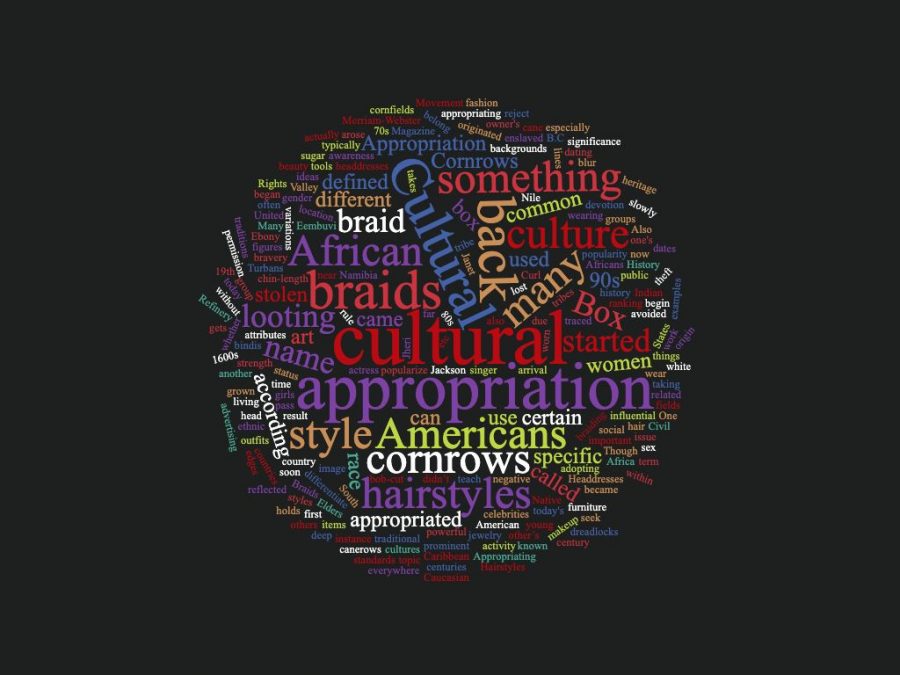Cultural Appropriation: What It Is and Why It Matters
January 7, 2020
“Cultural appropriation” is defined by Merriam-Webster as an instance of appropriating something related to culture. “Appropriating” is defined as taking something for one’s own use, typically without the owner’s permission.
This issue has been a topic for centuries, dating back to the 1600s, but it was first called “cultural looting.” Also known as “art theft,” cultural looting often arose between different countries, whether the ideas stolen were art, tools, furniture, etc.
But now cultural looting has grown another head, and its name is cultural appropriation, which is when a race or ethnic group wear something that does not belong to their own race or culture. There are many items that can be appropriated, such as hairstyles, outfits, certain makeup styles, and many other things.
There are so many cultures in the United States that the lines begin to blur, from certain hairstyles to specific traditions. Cultural appropriation is everywhere, especially within advertising and fashion.
One of the most common examples of cultural appropriation today is when a Caucasian of any sex gets cornrows, box braids, or dreadlocks, or does their edges. The origin of these hairstyles holds deep significance that is “stolen” when appropriated by others.
“Cornrows” is a term started in the 19th century, but the braid style actually dates as far back as 3,000 B.C., according to Cultural Appropriation Hairstyles by Refinery 29. The name came from the cornfields that African Americans would work in; in the Caribbean, they would be called “canerows” because of the sugar cane fields common there. In the ’70s, after the Civil Rights Movement, African Americans slowly started to reject white beauty standards and began to seek out hairstyles that reflected their heritage. Though they lost popularity in the ’80s due to the arrival of the Jheri Curl, cornrows came back as a result of many ’90s celebrities adopting the style.
Cornrows are important to African Americans because wearing them takes back something that once had a negative image. But cornrows are not the only style with history.
Box braids were used to differentiate Africans by tribe, status, location, social ranking, and other attributes. Box braids didn’t have a specific name until the ’90s when singer and actress Janet Jackson started to popularize them. This style of braiding can be traced back to Eembuvi braids from Namibia, and also the chin-length bob-cut braid of women living near the Nile Valley, according to The History of Box Braids by Ebony Magazine.
Elders in tribes would teach young girls how to braid each other’s hair, and soon it became an activity used to pass the time. Many different groups of enslaved African Americans would use both box braids and cornrows to represent a map of a possible way to escape their slave owner’s property. Women would place beads, jewels, or shells in their braids to show that they were ready for children, or that they had a high social status, according to How Cornrows Were Used as an Escape Map From Slavery Across South Africa.
Often, cases of cultural appropriation are caused by celebrities and various companies. One notable example was back in early 2018 when the designer brand Gucci put turbans on white models. Another is when singer and songwriter Pharrell Williams wore a Native American headdress on the cover of an edition of the British magazine Elle. In addition, many celebrities, including Selena Gomez at the 2013 MTV Music Awards, Vanessa Hudgens in 2014, Katy Perry at the 2011 Grammys, and Miley Cyrus throughout 2010 have worn a bindi, a mark worn in the middle of the forehead by certain Indian women.
The issue behind each of these instances of appropriation is that these things are very important to the cultures in which they originated.
Turbans themselves have many cultural backgrounds behind them. Depending on the country, the turban can either belong to a Muslin, Hindu, or Sikh person, stretching across the Mediterranean and Southern Asia.
Headdresses represent bravery and strength within Native American culture. The Sioux are believed to be the first to wear feathered headdresses. Headdresses are mainly worn by the most powerful or/and influential in the tribe and take a long time to make. A feather would be added to the headdress each time either a chief, an influential member, or a warrior committed an act of bravery, according to The Significance of the Native American Headdress by the website, Tribal Trade.
Bindis, which have been used for approximately 5,000 years, are not only worn in India but also in Nepal, South Asia, Sri Lanka, and other places. With variations from pastes to jewelry, bindis hold many different meanings, but the traditional meaning of this mark between the eyes represents the “third eye.” Although mainly women wear bindis, there wasn’t always such a gender rule regarding wearing a bindi. It was used as a symbol of devotion to the intellect of both men and women, according to the Purpose of the Bindi an article by Shuvi Jha.
Cultural appropriation is very prominent, but it is not as seen or pointed out enough in today’s culture as it should be. Today’s public figures say they are aware that it should be avoided, but even with that “awareness,” cultural appropriation keeps reappearing like jet lag or the common cold.


